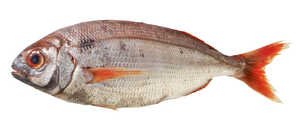Tuna boat
The tuna boat was the largest of all the inshore vessels at
around 13 metres in length. From December to March it was
used for bream fishing.
For this task, which was performed using trawl lines, it had
a crew of around twenty. The characteristics of the boat were
not particularly important in the fishing operation. However,
from May to October, the same vessel, with somewhat under
half the crew, was used for fishing for bonito and tuna.
They used the dynamic technique of trolling, putting out
long rods to cast the tackle out on either side. This consisted
of a single or double hook, covered with feathers or corn
leaves and decorated with a piece of coloured cloth or wool
to mimic a fish.
The boat was designed to reach the necessary speed to make
the lures dance around in the water and thus trick the tuna
into biting.The tuna boat was the largest of all the inshore vessels at
around 13 metres in length. From December to March it was
used for bream fishing.
For this task, which was performed using trawl lines, it had
a crew of around twenty. The characteristics of the boat were
not particularly important in the fishing operation. However,
from May to October, the same vessel, with somewhat under
half the crew, was used for fishing for bonito and tuna.
They used the dynamic technique of trolling, putting out
long rods to cast the tackle out on either side. This consisted
of a single or double hook, covered with feathers or corn
leaves and decorated with a piece of coloured cloth or wool
to mimic a fish.
The boat was designed to reach the necessary speed to make
the lures dance around in the water and thus trick the tuna
into biting.

Tuna boats leaving the port of Ondarroa at dawn, by Darío de
Regoyos. The painting shows the figures decorating the sails, used
to identify different boats at a distance. © José Lopez

The San Francisco, a tuna boat from Bermeo, photographed in
1917. These were the last years of sail-powered fishing boats;
having competed with steam boats for several decades, they had
grown to be up to 16 metres in length. This is a "txalupa handia",
(large chalupa in Basque), a name given to the larger decked tuna
boats that emerged at the end of the nineteenth century. © José Lopez

Tuna boats in harbour after passing the sand bar in
Hondarribia. © José Lopez

Brokoa. Large tuna boat built by the Itsas Begia association
from Saint Jean de Luz, based on a plan in the Mutiozabal collection.
The advantages of this type of boat were demonstrated in the
voyage between the Breton town of Douarnenez and Sokoa, completed
in just 42 hours, in the summer of 2006. © José Lopez

Albacore. © José Lopez

Hake. © José Lopez

Bream. © José Lopez

The tuna boats had washboards which were placed on the
gunwale to increase the freeboard when under sail and prevent
water from getting into the vessel. The sails were generally decorated,
and the hulls too were painted with motifs to make them easier
to identify. In this case, a white border frieze can be seen beneath
the gunwale with alternating rectangles. © José Lopez

The Marquis of Folin, harbourmaster at Bayonne, took a great
interest in the smaller Basque vessels, making studies and plans of
various types of boat. This drawing shows the arrangement of the
rods along the side of the tuna boat in some detail. © José Lopez

Example of the watertight deck. The larger tuna boats were a
result of the requirement by marine authorities that all boats should
have a watertight deck. This rule was introduced to reduce the
number of wrecks suffered by open-sided tuna boats. © José Lopez














